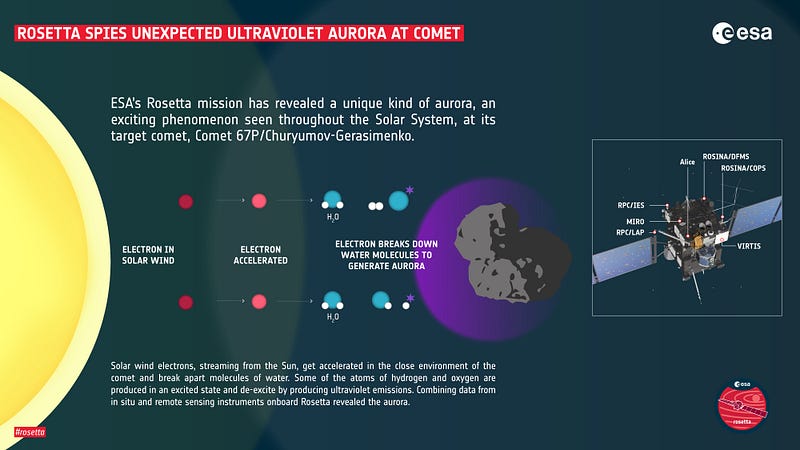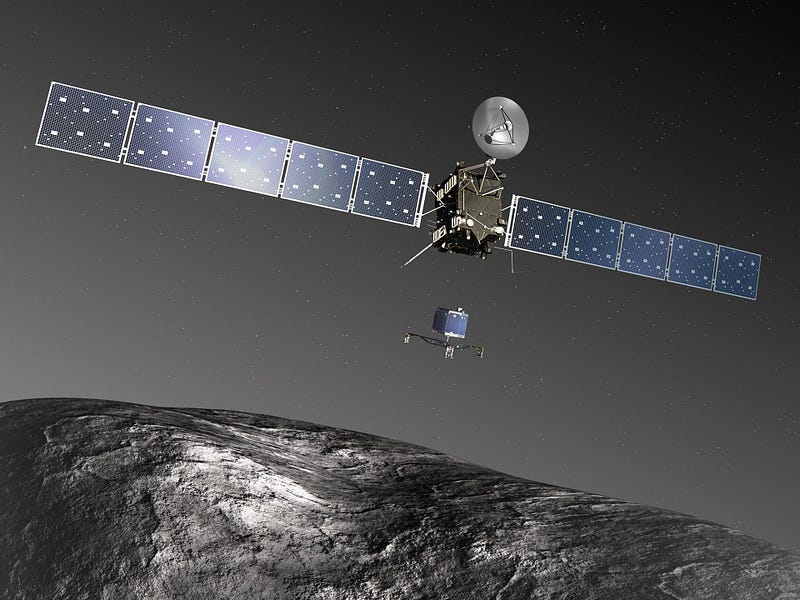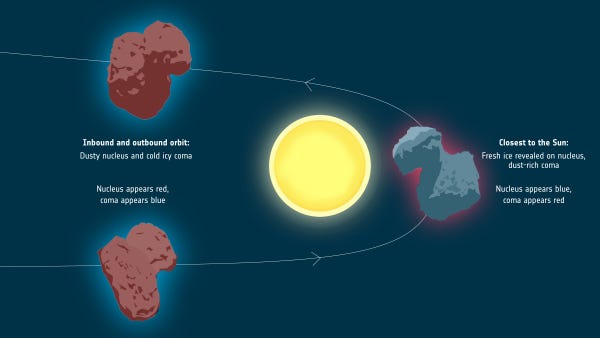Astonishing Discoveries: Ultraviolet Aurora Observed at Comet Chury
Written on
Chapter 1: Introduction to Comet Chury's Aurora
As Comet Chury approaches its perihelion, gas and dust are released from its surface, showcasing the dynamic nature of this celestial body. The recent identification of an ultraviolet aurora surrounding Comet 67P/Churyumov-Gerasimenko, commonly known as Chury, marks a significant milestone in astronomical research. This discovery underscores the ongoing scientific contributions of the European Space Agency's Rosetta mission, even years after its conclusion.
The stunning display of Earth’s auroras, famously known as the Northern Lights, has captivated viewers for generations. However, researchers have now confirmed that auroras are not exclusive to Earth, as other celestial objects, including planets and moons, exhibit similar phenomena. A team from the University of Bern has successfully identified an ultraviolet aurora around Chury for the first time.
Section 1.1: The Mechanism Behind the Aurora
The ultraviolet glow observed around Chury results from solar wind electrons colliding with the comet's coma—the cloud of gas surrounding it. This process is akin to the mechanisms that generate Earth's auroras but differs significantly in some respects.
“Rosetta is the first mission to detect an ultraviolet aurora at a comet,” states Matt Taylor, ESA project scientist. “The thrill of discovering auroras in new locations or with unique characteristics is unparalleled.”
Marina Galand, the lead author of the study from Imperial College London, elaborates on the phenomenon: “The resulting glow is unique and arises from a combination of processes similar to those observed on Jupiter's moons Ganymede and Europa, alongside those at Earth and Mars.”
The first video titled "Astronomers Spot Comet Chury's Ultraviolet Aurora" delves into the groundbreaking discovery of this ultraviolet aurora, highlighting how it enriches our understanding of cometary science and solar interactions.
Section 1.2: Historical Context of the Rosetta Mission
Chury’s ultraviolet aurora was first identified through data analysis from the Rosetta mission. Previously, this glow had been mistaken for sunlight photons, akin to Earth's airglow. The study, published in Nature Astronomy, is a testament to the mission's lasting impact.

The team's investigation involved proving that the ultraviolet emissions were a direct result of solar wind electrons interacting with the comet's gases rather than a misinterpretation as airglow. Martin Rubin from the University of Bern emphasizes the significance of this process: “Since this interaction is highly energetic, the resulting emissions fall within the ultraviolet spectrum, which is invisible to the naked eye.”
Chapter 2: Unique Characteristics of Cometary Auroras
One intriguing aspect of Chury’s aurora is its independence from a magnetic field, unlike Earth’s. This revelation could open new avenues for studying solar wind interactions with comets.
“The aesthetic appeal of cometary auroras is undeniable,” Rubin notes. “Moreover, ultraviolet observations from Earth may eventually enhance our understanding of solar winds affecting comets, even in the absence of a spacecraft like Rosetta.”
The analysis relied on various instruments aboard Rosetta, including the Rosetta Orbiter Spectrometer for Ion and Neutral Gas Analysis (ROSINA), which played a crucial role in determining Chury's composition and coma density.
The second video titled "Northern Lights on a Comet!" explores how similar auroral phenomena can be observed on comets, drawing parallels with Earth’s Northern Lights and expanding our understanding of these cosmic events.
As the Rosetta mission concluded with the controlled impact of its lander on Chury in September 2016, it left behind a legacy of groundbreaking discoveries. After two years of remote studies, the spacecraft's journey to Chury began in 2014, following a decade-long voyage that included encounters with asteroids.

Early in the mission, Rosetta's data led to the identification of critical chemical elements essential for life, such as glycine—an amino acid integral to DNA. This finding supports the theory that life's building blocks may have arrived on Earth via cometary impacts.
In February of this year, research based on Rosetta's findings revealed that Chury's nucleus underwent a color change during its orbit, further showcasing the mission's invaluable contributions.

Rosetta’s dedication to tracking Chury over time has unveiled secrets that continue to surprise scientists. As Kathrin Altwegg from the University of Bern notes, “The complexity of the analysis required multiple instruments, even years after the mission's official end.”
Original research: M. Galand, P. D. Feldman, D. Bockelée-Morvan, N. Biver, Y.-C. Cheng, G. Rinaldi, M. Rubin, et al, ‘Far ultraviolet aurora identified at comet 67P/Churyumov-Gerasimenko,’ Nature Astronomy, [2020].